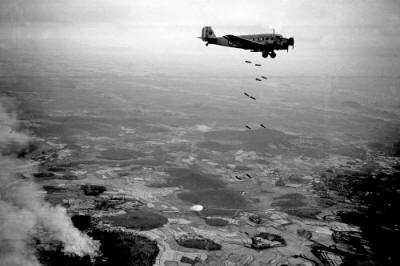|
from TheDailyBeast Website
In March 1969, American helicopters flying over a western part of South Vietnam spotted a group of Vietnamese cutting wood.
Circling the group, the Americans grew angry when none of the woodcutters looked up. But the Vietnamese had good reason. American policy held that if a Vietnamese looked at a hovering chopper, he must be Viet Cong.
The Americans began dropping canisters of tear gas, which ignited a blaze.
When the woodcutters turned to flee, the
Americans blasted away with rockets and machine guns, leveling the forest
and killing all but one of them.
BOMBING VIET MINH INDOCHINA
WAR of 100-pound bombs over suspected Communist Viet Minh positions
on March 16, 1951, some 100
miles north of Hanoi. (Levy/AP)
Nevertheless, no American was punished for their
murders. Why? The soldiers were simply following policy, which said that if
Vietnamese ran, they must be Viet Cong.
Turse has received wide acclaim for revealing the vast extent of American atrocities and for obliterating the notion that “a few bad apples” were responsible.
He tells of Americans,
While many of these stories are told sparsely, others are recounted in excruciating detail by a surviving victim.
There's the story of Bui Thi Huong, for example, who was 18 years old in 1966 when Marines ransacked her home. After five soldiers gang-raped her, they shot her and her sick husband and four other family members, including their 3-year-old son and a 5-year-old girl.
As the Marines covered up the scene, they discovered the 5-year-old still breathing, so one soldier lifted his rifle and, as the others counted in unison, smashed her with the butt until she died.
But beyond the litany of atrocities, his book contains far-reaching implications that have been overlooked.
One of Turse's key sources is a file by the Vietnam War Crimes Working Group (VWCWG) - a secret Pentagon panel tasked with determining how to prevent future war-crimes scandals.
The group's very existence is evidence that the Pentagon sought to learn lessons about public manipulation from Vietnam.
For instance, Turse describes how the Defense Department became increasingly nervous that the narrative it had concocted for Vietnam - that America was on the verge of victory and that the massacre at My Lai was an aberration - was dissolving.
Turse uses the example of Operation Speedy
Express, the annihilation of the Mekong Delta between 1968 and 1969.
Initially lauded as a huge success because of its staggering “body count,”
it gradually came to light that civilians composed the bulk of the dead.
But the Pentagon learned its lessons well.
Looking at America's wars since 9/11, alarming similarities exist with Vietnam, particularly in the killing of civilians through the reckless overuse of our latest weaponry and the documented use of torture.
Yet modern public outcry has been practically muted. This is the result of skillful policy: embedding journalists to control media coverage rather than allowing journalists freer reign as during Vietnam and assembling a vast modern PR apparatus to respond to crises and disseminate propaganda.
(According to the war correspondent Michael Hastings, DoD now employs 27,000 media professionals at $4.7 billion per year and even creates phony Facebook and Twitter accounts of pro-American Afghans.)
This huge PR machine has been accompanied by a strategy of public disengagement - through policies like the elimination of the draft, a refusal to raise wartime taxes, and an increasing reliance on long-range weapons like drones.
All of this makes war far less impactful to most
Americans.
They are incredibly difficult to read and share a common thread:
But they are war crimes, after all, and every one demands a hearing.
The brilliance of Turse's book is that he uses these awful tales to reveal the implications of our ever-expanding military spin machine. Because even though it took a long time for many atrocity stories to emerge from Vietnam, they eventually did.
How many tales like the Vietnamese woodcutters
occurred in Iraq and Afghanistan? Will their stories ever be heard? Sure,
some of them have been, but one suspects there are many more.
With the Afghanistan war and the war on terror entering their 12th years, Turse demonstrates that only by coming to grips with the full horror of Vietnam can we understand why we are dangerously close to that perpetual state...
|


